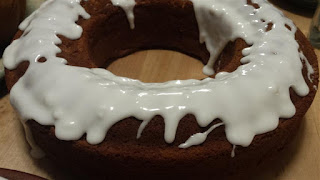I made a double batch of this cake and Cake #28 on 3/3/19. This one was much easier than #28, but not as tasty. After taking it to work the next day, my co-workers were complementing me on THIS ONE. I figured the rum glaze had soaked into the cake overnight and made the cake a bit softer and tastier!
This cake calls for a lot of honey, so even if you have some honey, make sure you have enough.
I made one in a tube pan and one in a bundt pan. Both turned out fine and worked well for the glaze to drip down the sides.
After making this I immediately sat down and re-wrote the order. Next time, I would beat the egg whites first in the kitchen aid mixer, then pour them into a separate bowl, wash the mixer and use it for the cake batter, then fold in the egg whites to the kitchen aid bowl, which is large enough to handle a double batch.
I would also mix all the dry ingredients either the day before, or after beating the eggs, before doing anything else, so they are ready to go. You know, like how they do it on tv!
The recipe calls for an extra egg white (2 if doing a double batch)- so you'll have leftover yolks. We separated the eggs while making breakfast and mixed the 2 yolks in w/ whole eggs for yolk-heavy scrambled eggs.
The glaze frosting (double batch) calls for 2 1/2 c of powdered sugar mixed with 3 T of rum. I only used 2 c of sugar and it was very hard/clumpy, so I added milk, pouring a little in at a time, until it had a thick frosting consistency. The rum flavor was very subtle, so I could have added more rum and less milk.












